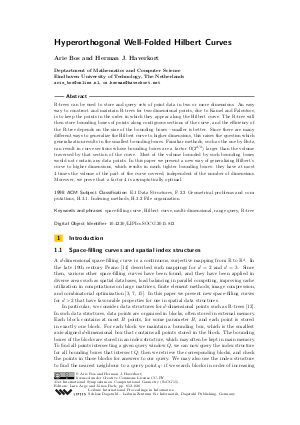Hyperorthogonal Well-Folded Hilbert Curves
Authors Arie Bos, Herman J. Haverkort
-
Part of:
Volume:
31st International Symposium on Computational Geometry (SoCG 2015)
Part of: Series: Leibniz International Proceedings in Informatics (LIPIcs)
Part of: Conference: Symposium on Computational Geometry (SoCG) - License:
 Creative Commons Attribution 3.0 Unported license
Creative Commons Attribution 3.0 Unported license
- Publication Date: 2015-06-12
File

PDF
LIPIcs.SOCG.2015.812.pdf
- Filesize: 0.57 MB
- 15 pages
Document Identifiers
Subject Classification
Keywords
- space-filling curve
- Hilbert curve
- multi-dimensional
- range query
- R-tree
Metrics
- Access Statistics
-
Total Accesses (updated on a weekly basis)
0Document
0Metadata
Abstract
R-trees can be used to store and query sets of point data in two or more dimensions. An easy way to construct and maintain R-trees for two-dimensional points, due to Kamel and Faloutsos, is to keep the points in the order in which they appear along the Hilbert curve. The R-tree will then store bounding boxes of points along contiguous sections of the curve, and the efficiency of the R-tree depends on the size of the bounding boxes - smaller is better. Since there are many different ways to generalize the Hilbert curve to higher dimensions, this raises the question which generalization results in the smallest bounding boxes. Familiar methods, such as the one by Butz, can result in curve sections whose bounding boxes are a factor Omega(2^{d/2}) larger than the volume traversed by that section of the curve. Most of the volume bounded by such bounding boxes would not contain any data points. In this paper we present a new way of generalizing Hilbert's curve to higher dimensions, which results in much tighter bounding boxes: they have at most 4 times the volume of the part of the curve covered, independent of the number of dimensions. Moreover, we prove that a factor 4 is asymptotically optimal.
Cite As Get BibTex
Arie Bos and Herman J. Haverkort. Hyperorthogonal Well-Folded Hilbert Curves. In 31st International Symposium on Computational Geometry (SoCG 2015). Leibniz International Proceedings in Informatics (LIPIcs), Volume 34, pp. 812-826, Schloss Dagstuhl – Leibniz-Zentrum für Informatik (2015)
https://doi.org/10.4230/LIPIcs.SOCG.2015.812
BibTex
@InProceedings{bos_et_al:LIPIcs.SOCG.2015.812,
author = {Bos, Arie and Haverkort, Herman J.},
title = {{Hyperorthogonal Well-Folded Hilbert Curves}},
booktitle = {31st International Symposium on Computational Geometry (SoCG 2015)},
pages = {812--826},
series = {Leibniz International Proceedings in Informatics (LIPIcs)},
ISBN = {978-3-939897-83-5},
ISSN = {1868-8969},
year = {2015},
volume = {34},
editor = {Arge, Lars and Pach, J\'{a}nos},
publisher = {Schloss Dagstuhl -- Leibniz-Zentrum f{\"u}r Informatik},
address = {Dagstuhl, Germany},
URL = {https://drops.dagstuhl.de/entities/document/10.4230/LIPIcs.SOCG.2015.812},
URN = {urn:nbn:de:0030-drops-50962},
doi = {10.4230/LIPIcs.SOCG.2015.812},
annote = {Keywords: space-filling curve, Hilbert curve, multi-dimensional, range query, R-tree}
}
Author Details
References
-
J. Alber and R. Niedermeier. On multidimensional curves with Hilbert property. Theory of Computing Systems, 33(4):295-312, 2000.

-
L. Arge, M. de Berg, H. Haverkort, and K. Yi. The Priority R-tree: a practically efficient and worst-case optimal R-tree. ACM Tr. Algorithms, 4(1):9, 2008.

-
M. Bader. Space-filling curves: an introduction with applications in scientific computing. Springer, 2013.

-
A. R. Butz. Alternative algorithm for Hilbert’s space-filling curve. IEEE Trans. Comp., 20(4):424-426, 1971.

-
H. Haverkort. An inventory of three-dimensional Hilbert space-filling curves. CoRR, abs/1109.2323, 2011.

-
H. Haverkort. Harmonious Hilbert curves and other extradimensional space-filling curves. CoRR, abs/1211.0175, 2012.

-
H. Haverkort and F. van Walderveen. Locality and bounding-box quality of two-dimensional space-filling curves. Computational Geometry, 43(2):131-147, 2010.

-
H. Haverkort and F. van Walderveen. Four-dimensional Hilbert curves for R-trees. ACM J. Experimental Algorithmics, 16:3.4, 2011.

-
D. Hilbert. Über die stetige Abbildung einer Linie auf ein Flächenstück. Math. Ann., 38(3):459-460, 1891.

-
I. Kamel and C. Faloutsos. On packing R-trees. In Conf. on Information and Knowledge Management, pages 490-499, 1993.

-
K. V. R. Kanth and A. K. Singh. Optimal dynamic range searching in non-replicating index structures. In Int. Conf. Database Theory, LNCS 154, pages 257-276, 1999.

-
Y. Manolopoulos, A. Nanopoulos, A. N. Papadopoulos, and Y. Theodoridis. R-trees: Theory and Applications. Springer, 2005.

- D. Moore. Fast Hilbert curve generation, sorting, and range queries. http://web.archive.org/web/www.caam.rice.edu/~dougm/twiddle/Hilbert/, 2000, retrieved 23 March 2015.
-
G. Peano. Sur une courbe, qui remplit toute une aire plane. Math. Ann., 36(1):157-160, 1890.

-
H. Sagan. Space-Filling Curves. Universitext. Springer, 1994.

-
S. Sasburg. Approximating average and worst-case quality measure values for d-dimensional space-filling curves. Master’s thesis, Eindhoven University of Technology, 2011.

-
J.-M. Wierum. Definition of a new circular space-filling curve: βΩ-indexing. Technical Report TR-001-02, Paderborn Center for Parallel Computing PC², 2002.

